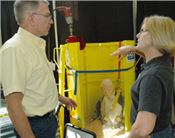|
Review Grain Bin Rules Before Harvest

MU Extension specialists Bob Schultheis and Karen Funkenbusch say grain rescue tubes like the one shown here help save lives.
Photo credit: Linda Geist, MU Extension
COLUMBIA, MO.
The difference between a grain bin rescue and a recovery is seconds. Increased public awareness and new tools help save lives, says University of Missouri Extension health and safety specialist Karen Funkenbusch.
Farm Safety & Health Week, Sept. 20-26. is a good time for farmers to discuss grain bin safety with family members and farmworkers, Funkenbusch says.
This year’s theme, “Ag Safety is not just a slogan, it’s a lifestyle,” rings true for Funkenbusch.
Due to increased training and more public awareness, deaths from grain bin entrapments steadily declined until 2014. That year saw 38 documented entrapments nationally, resulting in 17 deaths, including one in Missouri. This surge may be attributed to a record corn harvest and more on-farm storage, Funkenbusch says.
Grain bin entrapments can happen when farmers climb inside the bin and use a long pole to clear a crust of kernels that are stopping corn from funneling out of the bin. Crusting creates a firm but unstable top layer of grain. It may feel hard enough for walking, but grain flowing below the crust creates a cavity that collapses in seconds.
Flowing grain is a farmer’s worst nightmare, Funkenbusch says. The speed and weight of flowing grain make it almost impossible to escape.
Today’s farm equipment is larger, quicker and more automated, letting farmers work alone. Bins are larger and more dangerous.
Prevent grain accidents by reviewing safety rules with family members and workers before harvest begins, Funkenbusch says.
• Develop a “zero entry” mentality. Stay out of the bin unless absolutely necessary.
• If you have to check the grain, don't go alone and let others know you are doing this to prevent them from turning on the auger.
• Check lockout control circuit devices on the auger before entering the bin.
• Run ventilation equipment before entering a bin to release toxic fumes.
• Wear a safety harness and have a trained observer with you.
• If someone becomes entrapped, do not attempt a rescue on your own. Many fatal grain bin accidents involve more than one death because observers die while making a rescue attempt. Call 911, turn off the auger or conveyor belt, and turn on fans to increase ventilation.
• Train other family members and farmworkers to stay out of the bin. Keep ladders away to help children avoid the temptation to enter bins and wagons. Lock bins.
What if you find yourself trapped in a bin? Funkenbusch offers these ideas:
• Cup your hands around your mouth and nose to create an air pocket. This may give you enough air and time for someone to rescue you.
• If possible, move to the edge of the bin and continue moving in a spiral until the bin is empty. Try to get to the inside ladder of the bin.
For more information, see the MU Extension publication “Safe Storage and Handling of Grain” (G1969), available for free download at www.extension.missouri.edu/p/G1969.
The Occupational Health and Safety Administration has information on grain handling safety at www.osha.gov/SLTC/grainhandling. ∆
|
|